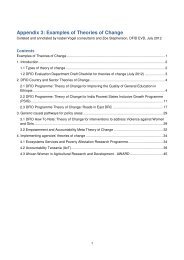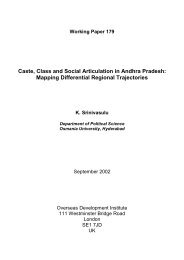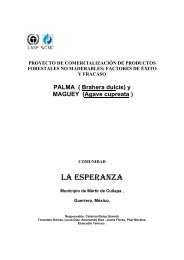Full Report - Research for Development - Department for ...
Full Report - Research for Development - Department for ...
Full Report - Research for Development - Department for ...
Create successful ePaper yourself
Turn your PDF publications into a flip-book with our unique Google optimized e-Paper software.
Drug treatments (including micronutrient supplementation)<br />
Vaccinations<br />
Other clinical management<br />
Surgical/instrumental procedures<br />
Only one study aimed at improving infant mortality outcomes was focused on<br />
surgical intervention. In a retrospective study based in Amman, Jordan, Ziadeh<br />
(2000) (-)/(-) sought to determine the perinatal outcomes associated with triplet<br />
pregnancies and compare outcomes <strong>for</strong> Caesarean section with vaginal delivery.<br />
Caesarean section was not found to be advantageous but the sample size was very<br />
small (n=41).<br />
Synthesis results<br />
Drug treatments (including micronutrient supplementation)<br />
Six papers focused on drug treatments. One study focused on the use of drug<br />
treatments to improve infant outcomes (Kumwenda et al., 2008) (++)/(++). This<br />
randomised controlled trial in Malawi evaluated extended antiretroviral prophylaxis<br />
to reduce breast-milk HIV-1 transmission. Extended prophylaxis <strong>for</strong> the first 14<br />
weeks of life significantly reduced postnatal HIV-1 transmission at 9 months but<br />
there was not a significant difference in mortality at this stage of follow-up.<br />
Five studies focused on micronutrient supplementation to improve infant mortality<br />
outcomes. A randomised controlled trial in urban Zimbabwe (Malaba et al., 2005)<br />
(++)/(++) measured the effect on infant mortality of supplementing neonates and<br />
their HIV-negative mothers with single, large doses of vitamin A during the<br />
immediate postpartum period, but found no significant impact. A controlled<br />
experimental study located in a peri-urban Indonesian community (Cobra et al.,<br />
1997) (++)/(++) showed a positive impact on infant mortality outcomes as a result of<br />
oral iodine supplementation. The study concluded that in populations at risk of<br />
iodine deficiency, oral iodized oil supplementation of infants may reduce infant<br />
mortality. Furthermore, a study from China examined the effect of water treatment<br />
with iodine on infant and neonatal mortality (de Long et al., 1997) (+)/(+). The<br />
authors concluded that iodine replacement through iodination of irrigation water<br />
was possibly an important factor in the recorded decline in infant mortality in China<br />
in areas with severe iodine deficiency. Finally, in Egypt, increased availability of oral<br />
rehydration salts (ORS) was associated with an improvement in the case<br />
management of, and mortality from, diarrhoea (Miller et al., 1994) (+)/(++).Finally,<br />
Joshi et al. (2007) (-)/(-) showed that inhalational nitric oxide (INO) can be life<br />
saving and cost-effective in a LIC setting such as India.<br />
Vaccinations<br />
Eleven papers focused on vaccinations. All studies on vaccinations included in this<br />
review focused on infant outcomes. Vaccination remains a key prevention tool to<br />
reduce IMR in low resource settings. This review found 10 studies looking at ways to<br />
implement vaccination programmes to improve infant and neonatal mortality. Amin<br />
et al. (1992) (-)/(-) looked at the impact of the Expanded Program on Immunization<br />
in Sierra Leone and found that immunisation had a dramatic effect on infant<br />
mortality declines between 1975 and 1990. A series of studies from Guinea Bissau<br />
provide evidence relating to measles and BCG vaccinations and their impact on<br />
infant mortality. Aaby et al. (2002) (+)/(+), working in urban, peri-urban and rural<br />
areas of Guinea Bissau, compared measles-vaccinated children with those not<br />
vaccinated, and the <strong>for</strong>mer showed significantly lower levels of mortality. Martins<br />
Cesario et al. (2008) (++)/(++) further confirmed the results, showing that outbreaks<br />
of measles can be curtailed by giving the measles vaccine as early as 4.5 months of<br />
age. Bacillus Calmette-Guerin (BCG) vaccine on the other hand does not show<br />
straight<strong>for</strong>ward results. Garly et al. (2003) (+)/(-), also working in a peri-urban area<br />
What are the effects of different models of delivery <strong>for</strong> improving maternal and infant health<br />
outcomes <strong>for</strong> poor people in urban areas in low income and lower middle income countries? 33









